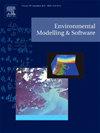Improved TDS forecasting in data-scarce regions using CEEMDAN and AI-driven hydro-climatic analysis
IF 4.6
2区 环境科学与生态学
Q1 COMPUTER SCIENCE, INTERDISCIPLINARY APPLICATIONS
引用次数: 0
Abstract
Total dissolved solids (TDS) are a key water quality parameter, reflecting the concentration of dissolved salts in aquatic systems. Accurate TDS forecasting is essential for sustainable water resource management, particularly in data-scarce regions. This study proposes a novel and generalized AI-based framework to forecast TDS up to six months ahead using a limited set of hydro-climatic input variables. The methodology combines Complete Ensemble Empirical Mode Decomposition with Adaptive Noise (CEEMDAN) for signal denoising and pattern extraction with advanced machine learning models, including Random Forest (RF) and a hybrid Grey Wolf Optimization–Support Vector Machine (GWO-SVM). To enhance model transferability, only four widely available input variables—precipitation, evaporation, discharge, and chloride concentration—were used. Historical data from 1975 to 2016 were collected from three hydrometric stations representing distinct climatic conditions. Forecasting was conducted both with and without the inclusion of lagged TDS values. The CEEMDAN-GWO-Linear SVM model achieved high accuracy (R2 = 0.70–0.96) across different forecast horizons. Additionally, CEEMDAN significantly improved the predictive performance of both SVM and RF models. Feature importance analysis using RF ranked chloride concentration, discharge, precipitation, and evaporation as the most influential variables in TDS prediction. The proposed framework offers a robust, data-efficient solution for mid-term water quality forecasting.
利用CEEMDAN和人工智能驱动的水文气候分析改进数据稀缺地区TDS预测
总溶解固形物(TDS)是反映水体系统中溶解盐浓度的关键水质参数。准确的TDS预测对于可持续水资源管理至关重要,特别是在数据匮乏的地区。本研究提出了一种新的、广义的基于人工智能的框架,利用一组有限的水文气候输入变量,提前6个月预测TDS。该方法结合了完整集成经验模态分解和自适应噪声(CEEMDAN),用于信号去噪和模式提取,以及先进的机器学习模型,包括随机森林(RF)和混合灰狼优化-支持向量机(GWO-SVM)。为了提高模型的可转移性,只使用了四个广泛可用的输入变量——降水、蒸发、排放量和氯化物浓度。1975年至2016年的历史数据来自三个代表不同气候条件的水文站。无论是否包含滞后TDS值,都进行了预测。CEEMDAN-GWO-Linear SVM模型在不同的预测范围内均具有较高的预测精度(R2 = 0.70-0.96)。此外,CEEMDAN显著提高了SVM和RF模型的预测性能。特征重要性分析采用射频排序氯化物浓度、流量、降水和蒸发作为TDS预测中影响最大的变量。提出的框架为中期水质预测提供了一个强大的、数据高效的解决方案。
本文章由计算机程序翻译,如有差异,请以英文原文为准。
求助全文
约1分钟内获得全文
求助全文
来源期刊

Environmental Modelling & Software
工程技术-工程:环境
CiteScore
9.30
自引率
8.20%
发文量
241
审稿时长
60 days
期刊介绍:
Environmental Modelling & Software publishes contributions, in the form of research articles, reviews and short communications, on recent advances in environmental modelling and/or software. The aim is to improve our capacity to represent, understand, predict or manage the behaviour of environmental systems at all practical scales, and to communicate those improvements to a wide scientific and professional audience.
 求助内容:
求助内容: 应助结果提醒方式:
应助结果提醒方式:


